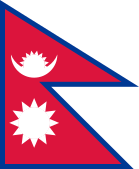2010 (5)
2011 (2)
2013 (42)
2015 (93)
2016 (126)
2017 (121)
2018 (90)
2019 (105)
2020 (233)
2021 (239)
2022 (249)
2023 (295)
2024 (367)

发现这个比例太可笑了。。。。
Flag of Nepal
 |
|
| Name | Nepali Flag, Triangle Flag, Chandra ra Surya |
|---|---|
| Use | National flag |
| Proportion | see below |
| Adopted | 16 December 1962 |
| Design | A combination of two red pennons (pennants) with the large blue border around the unique shape of two overlapping right triangles: the smaller upper triangle bears the white stylised moon (the rising sun on the horizontal crescent moon) and the larger lower triangle displays the white twelve-pointed sun. |

Variant flag of Nepal
|
|
| Use | Old flag of Nepal before 1962 |
The national flag of Nepal (Nepali: ??????? ?????) is the world's only non-quadrilateral national flag. The flag is a simplified combination of two single pennons (the vexillological word for pennants), known as a double pennon. Its crimson red is the colour of the rhododendron, Nepal's national flower, while the blue border is the colour of peace. Until 1962, the flag's emblems, the sun and the crescent moon, had human faces, but were removed to modernise the flag.
The current flag was adopted on 16 December 1962, along with the formation of a new constitutional government[citation needed]. It borrows from the original design, used throughout the 19th and 20th Centuries, and is a combination of the two individual pennons used for more than 2,000 years.[citation needed]
Contents
[hide]
Symbolism[edit]
After Prithvi Narayan Shah unified all small principalities of Nepal, the double-pennon flag was adopted. In modern times, the flag's symbolism has evolved to incorporate several meanings. The crimson red indicates the bravery of Nepali people and is the country's national colour and the blue border represents peace and harmony[citation needed]. The triangular shape of the pennons represents the Himalayas.
The inclusion of the celestial bodies indicates Nepal's permanence, and the hope that Nepal will enjoy the same longevity as the Sun and the Moon. Additionaly, the stylised moon represents the calm demeanour and purity of spirit of the Nepali people, while the stylised sun represents their fierce resolve[citation needed]. Further, the moon also symbolises the cool weather of the Himalayas, whereas the sun symbolises the heat and the high temperature of the Nepali lowlands (Terai).
Flag layout[edit]
A precise description of the Nepalese national flag in the Constitution of the Kingdom of Nepal, Article 5, Schedule 1, adopted 9 November 1990.[1]
Aspect ratio[edit]
According to the stated geometric construction law, the circumscribed rectangle has an irrational ratio of:
≈ 1:1.21901033… (![]() ?A230582).[2] This ratio is the least root of the quartic polynomial[3]
?A230582).[2] This ratio is the least root of the quartic polynomial[3]
and arises from the addition of the blue border after construction of the red field. The bounding rectangle of the red field alone has the rational aspect ratio 3:4 (=1:1.333…).[1]





